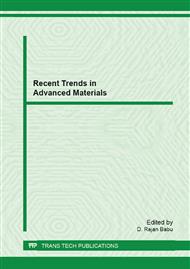p.299
p.303
p.308
p.313
p.319
p.324
p.329
p.334
p.341
Optimisation on the Growth and Alignment of ZnO Nanorods
Abstract:
Synthesis of aligned ZnO nanorods (NRs) is important for electronic and optoelectronic devices. In this work we demonstrate the growth of ZnO nanorods by co-precipitation method using zinc nitrate and hexamine precursors. The samples were characterized by X-ray diffraction analysis, Scanning electron microscopy and Raman spectroscopy. On introducing the seeded substrate into the growth solution, the seeds offer nucleation sites for one-dimensional growth of ZnO nanorods. ZnO nanorod arrays grown on the successive ionic layer adsorption and reaction (SILAR) seed layer found to be irregular and non-uniform due to the etching of the seed substrate by growth solution. However, dip-coated seed substrate yielded uniform growth of ZnO nanostructures. ZnO nanostructures with flower-like morphology were obtained for pH of 9. On reducing the pH of the growth solution the flower morphology transformed into rod-like morphology with rod diameter of 200nm. On reducing the pH to 3 the diameter of the nanorods is decreased to 20 to 25nm. On reducing the precursor concentration the faceted morphology of the nanorods changed into needle-like shape (with sharp tips) along with reduction in diameter (about 20nm). The growth of uniform and vertically aligned ZnO nanorods is observed in dip-coated seed substrate with 5 pH. The results indicate that the diameter of ZnO nanorod array could be controlled by varying the precursor concentration.
Info:
Periodical:
Pages:
319-323
Citation:
Online since:
October 2012
Keywords:
Price:
Сopyright:
© 2012 Trans Tech Publications Ltd. All Rights Reserved
Share:
Citation:


